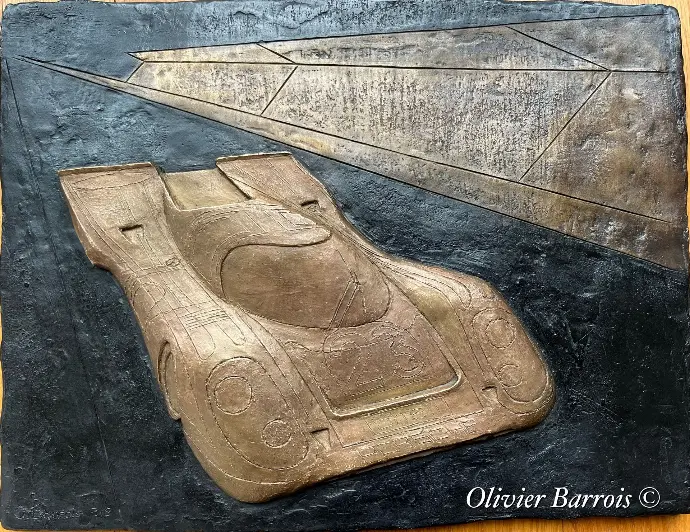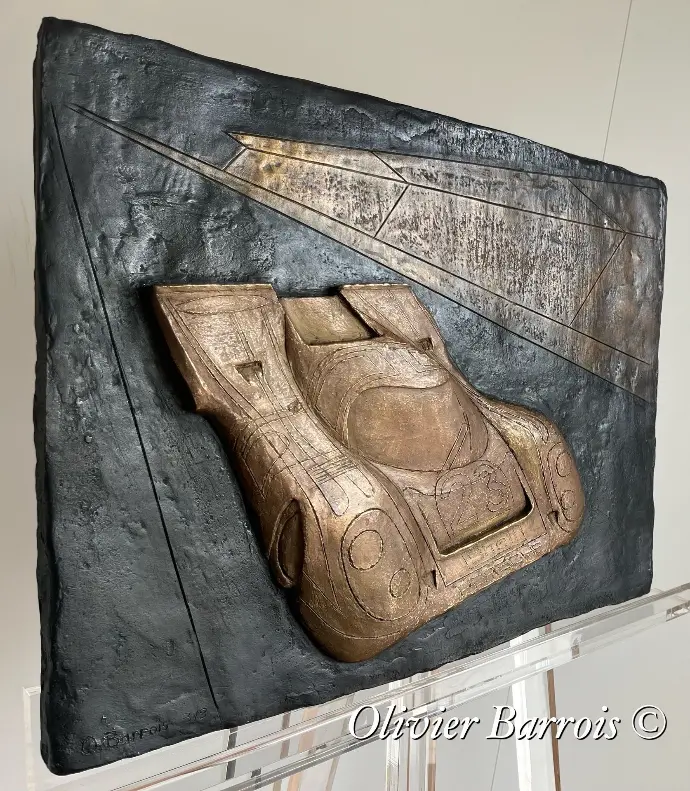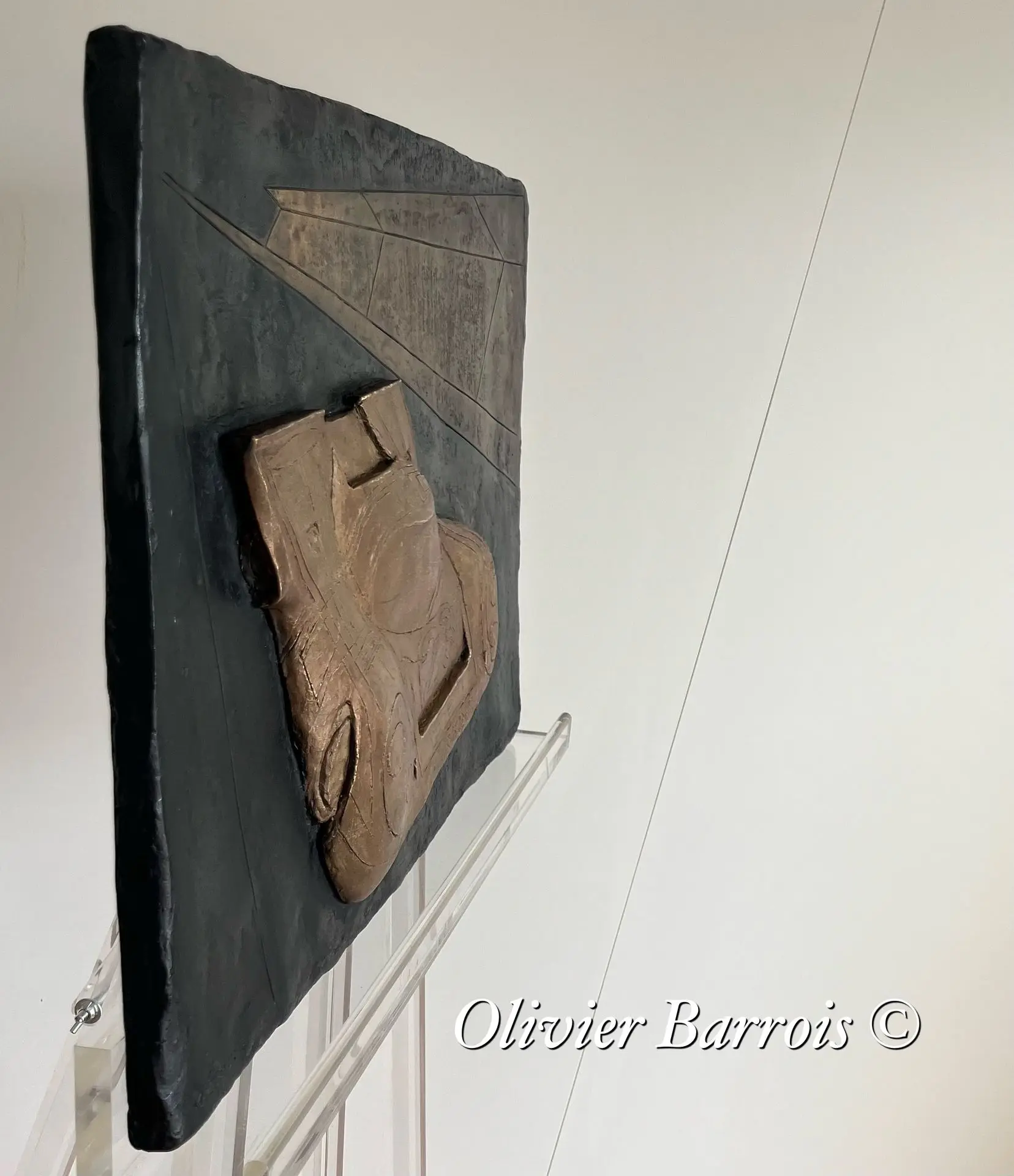Porsche 917 K n°23 "Salzburg"
Le Mans 1970 winner
Gold-like and transparent black background patina
This bas-relief pays tribute to the Porsche 917 K number 23 which became the first Porsche to win the 24 Hours of Le Mans in the general classification (Porsche having already won numerous class victories).
This historic victory, the supremacy of the Porsche 917, the very liberated visual of the bodies and decorations of each model will definitively change the status of the Porsche manufacturer to elevate it to the level of the greatest.
The History of the Porsche 917
The Porsche 917 was created with the aim of winning the 24 Hours of Le Mans. However, it will have to face the powerful Ford GT40, Lola T70 and other Ferrari 512 S.
Designed by Ferdinand Piëch, the nephew of the founder Ferry Porsche, the Porsche 917 is a low-slung coupé with a 4.5-litre flat-12 engine with a 180° opening, developing 580 hp. This coupé is inspired by the Porsche 908, which is equipped with a 3-litre flat-8 engine.
Lightness and aerodynamics were the top priorities. As a result, the Porsche 917's downforce was so low in its first year that drivers were afraid to drive it.
On March 12, 1969, less than a year after its design began, the 917 was unveiled at the Geneva Motor Show. The manufacturer offered the most powerful car it had ever produced, announcing a top speed of over 320 km/h. In the process, it ensured the release of the twenty-five copies required by March 31, 1969 at the latest, in order to obtain homologation. The financial effort was such that the manufacturer Porsche feared it would not survive.
There are two models of the original (coupe) version of the Porsche 917: the "LH" (for "Lang Heck" or "long tail" in english) and the "K" version (for "Kurz" or "short" in english).
The "LH" body was designed to improve top speed for racing on the Le Mans circuit. Faster than the "K" in top speed, it was however less manoeuvrable in corners and in the rain.
In total, 65 Porsche 917s will be built by Porsche, including 44 long-tail and short-tail coupes, as well as 21 Spyders.
The Porsche 917 alone won seventeen victories between 1969 and 1971, including twice in 1970 and 1971: the world championship, the double first and second at the 24 Hours of Le Mans and victory at the 24 Hours of Daytona.
In 1971 she broke the distance record for the 24 Hours of Le Mans with 5,335.31 km covered (an average speed of over 222 km/h), a record she held until 2010.
Due to their invincibility, the regulations were then changed, effectively excluding the 917 to revive competition. In 1972 and 1973, Porsche then launched into the North American CanAm series with the 917/10 and 917/30 (some then developed more than 1,100 horsepower, 1,400 hp with turbo) winning the eight events of the 1973 season.
The Porsche 917 remains for many one of the ultimate racing cars in the history of motorsport.
Victory at the 1970 24 Hours of Le Mans
Each of the seven 917s at the start of the 1970 24 Hours of Le Mans had its own visual signature, whether in terms of decoration or bodywork (short or long). Enough to further affirm the character of this extraordinary car, as well as its place in the legend of Porsche and the 24 Hours of Le Mans.
Fifteenth on the grid and last of the seven 917s at the end of qualifying, it was finally a short one (called K) that of Richard Attwood-Hans Herrmann (n°23) who took the lead at the eleventh hour and never relinquished it under terrible weather conditions.
It is distinguished by its red color with white flames around the front headlights, representing the Porsche Konstruktionen Salzburg team (hence its nickname "Salzburg") financed by Louise Piëch and managed by her son Ferdinand, respectively sister and nephew of the founder of the brand Ferry Porsche.


